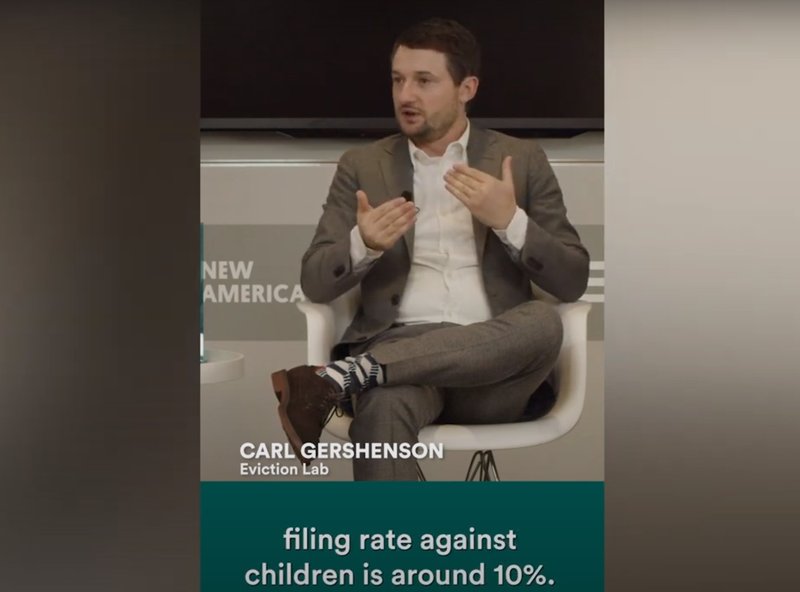Why are kids getting evicted at record rates? New America talks to Eviction Lab about evictions and child care
Blog Post

Jan. 8, 2024
Each year, millions of Americans are evicted from their homes. At its most basic, an eviction is the process by which a landlord can remove a tenant from a rental property, but that process can occur in a multitude of ways.
Despite the fact that evictions run through the court system, data on evictions is poor. There is no federal eviction database, and most local court data is messy, incomplete, and inaccessible. Even when records are available, they tell us very little: the name and address of the landlord and the tenant on the lease; the date an eviction filing and judgment takes place; and occasionally information about the amount of back rent a tenant owes, and whether they had attorney representation.
Using data from the Census Bureau, the Eviction Lab at Princeton University was able to see beyond the head of household whose name appears on a lease and on eviction filing court records. Lifting this veil found that more than half of households that receive an eviction filing have a child living within the home, and nearly 33 percent of the total population facing a filing is younger than 15. To make matters worse, more than 10 percent of children under the age of five live in rental households threatened with an eviction, and 5.7 percent experience an eviction each year.
Black children are especially at risk: Eviction Lab’s study found that every year, more than 25 percent of Black children who live in rental households undergo the first step in the eviction process by receiving an eviction filing. For Black children under the age of five, 12.4 percent will go on to be evicted. Many of these children live in households where a Black woman’s name is the only one on the lease, making Black women with children living in the home the demographic most at risk of experiencing an eviction in the United States.
Evictions impact children in deep and long-lasting ways. Children who have been evicted are twice as likely to be food insecure than their peers and score substantially worse on cognitive assessments and standardized tests. For their parents, evictions are linked to a higher prevalence of depression, anxiety, suicides, high blood pressure, and child maltreatment.
Could this high eviction rate for small kids be related to the lack of affordable, accessible child care across America? Unlike our wealthy peer nations that subsidize child care to keep costs affordable for families, the U.S. government invests shockingly little in child care. An analysis by the Department of Labor’s Women’s Bureau found that annual child care costs ranged from more than $5,000 to $17,000 per child, depending on the type of care, a child’s age, and population size of a county, and parents are on the hook for most of these costs. For single parents, infant care costs can eat up anywhere from 24 to 75 percent of family income.
Improving child care availability and bringing down costs is critical to making sure parents can pay the rent and keep their families stably housed. And building a universal care structure is one part of a broader network of care reforms that would help prevent families from being evicted in the first place. A report from the Women’s Bureau found that child care costs exceed the affordability threshold of seven percent of family median income in every U.S. county. Infant care costs more than in-state college tuition in more than 25 states. Parents are paying as much or more than their rent or mortgage for this level of child care, making affording both housing and care impossible for most, with Black women disproportionately affected.
At the same time, we also need to make housing more affordable and secure for tens of millions of working families who rent; half of U.S. renters now spend more than 30 percent of their income on housing. When households fall behind on rent payment, the risk of eviction increases.
For those facing eviction, right-to-counsel laws provide a critical lifeline. According to the National Low Income Housing Coalition, tenants with legal representation are more likely to stay in their homes, avoid the “Scarlet E” stigma, and receive extended time to vacate the property if the court rules against them. Emergency rental assistance programs are essential, too. During the pandemic, these programs distributed $46 billion to keep more than 10 million renters housed. But most of these programs are now inactive due to a lack of funding, and evictions are back to pre-pandemic levels in many places.
The lack of a social safety net is pushing families to the brink, making them choose between care for their children and keeping a roof over their heads. The money to kick start this effort exists: for instance, many states and localities haven’t allocated or spent all of the $350 billion in federal funds from the American Rescue Plan—money that must be allocated by December 31, 2024 and spent by 2026. This isn’t enough funding to build and sustain a universal care infrastructure, but it is a starting point to show what’s possible.
Policymakers just have to do it.